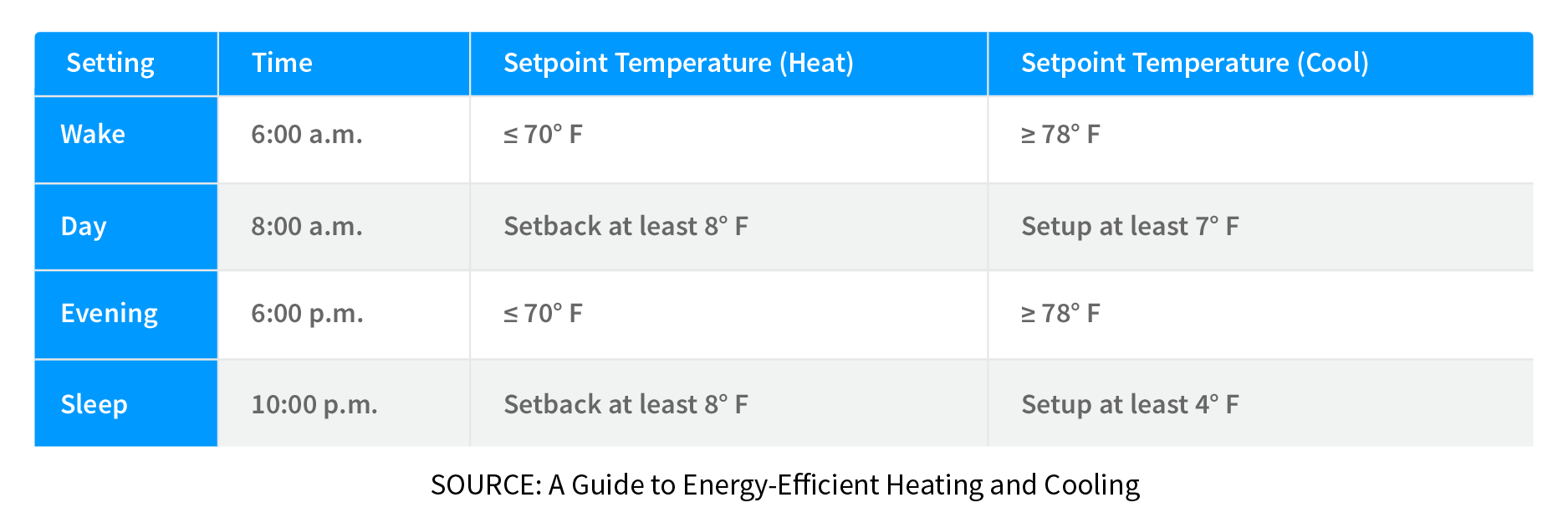How Smart is Your Thermostat?

Once upon a time, homeowners like you had to adjust their indoor temperatures by opening windows or fueling fires. Luckily, in 1883 a Wisconsin professor grew tired of having a cold classroom. The professor found himself continuously searching for the janitor in charge of the basement furnace who was responsible for adjusting dampers. As a result, the professor, Warren Johnson, invented the first thermostat.
The Basic Thermostat
Today, it’s hard to imagine a modern home without a device to set the desired indoor temperature. The basic thermostat, which has been a staple in home construction for a few decades, is designed to turn on the central heating and cooling system at one temperature and off at another. There are three basic operations that even the simplest thermostat has:
- A HEAT, COOL and OFF switch
- An ON or AUTO fan switch
- A means to increase or decrease the temperature settings
While these options provide functionality to your heating and cooling system, additional options may be required depending on your specific HVAC scenario. For example, a thermostat for a heat pump may include an option for auxiliary heat. The auxiliary heat switch activates the air handler’s (the most common inside component of a heat pump system) heat strips to turn on to supplement the output.
The Programmable Thermostat
With the entry of the programmable thermostat, the sophistication level of indoor temperature control was elevated. Some of the early programmable thermostats could be difficult to program. The newer ones of today are more intuitive and simpler to operate by comparison. By pre-programming temperature settings that align with lifestyles and preferences, homeowners can create an environment that makes their family most comfortable and potentially save money in the process. A programmable thermostat or control system can save you as much as $180 every year in energy costs when properly programmed.1
If you need assistance with determining set points times and temperatures, ENERGY STAR® suggests the following:2

The Smart Thermostat or Control System
But as today’s consumers are increasingly looking for ways to connect their lives and homes, intelligent heating and cooling devices are becoming more commonly accepted. Enter the smart thermostat or control system; a Wi-Fi enabled device that automatically adjusts heating and cooling temperature settings for optimal performance.3
In late 2016, the Environmental Protection Agency (EPA) finalized the first-ever ENERGY STAR® specification for smart thermostats. “The challenge in identifying household thermostats that save energy is accounting for how an individual or family ultimately sets the temperature.”4 “Anyone who cares about energy savings but is too busy to think about their heating and cooling use can be assured that these products have shown they help other busy families,” said Abi Daken, program manager for ENERGY STAR® HVAC products.5
When integrated with popular consumer electronics, homeowners now have the option of even more sophisticated indoor temperature control than with previous traditional or basic programmable thermostats. For example, both the Amazon Echo and Google Home integrate with the Honeywell Total Connect Comfort App to provide advanced inter-connectivity and voice control ability.
Amazon Echo is a wireless speaker that uses Alexa Voice Assistant to control devices in your home.
- The Amazon Echo allows direct control of certain smart thermostats or control systems, taking your home comfort to the next level.
- Homeowners can install the Alexa App on their smart home device. Once installed, you can search for the “skills” list for your particular smart thermostat. Amazon Alexa puts you in command of your home through voice controls that can be used with individual smart thermostats or group names. Here are a two examples of the commands you can use to operate your thermostat hands-free:
- The family cooking session was too hot. Ask Alexa to cool down the room. Command: “Alexa, lower the temperature by 3 degrees.”
- Too chilly for your guests? Alexa can make it warmer. Say: “Alexa, raise the temperature by 2 degrees.”
Google Home is a voice-activated speaker powered by the Google Assistant.
- Homeowners can control their smart thermostat control system hands-free, receive important notifications and automate their home to react to your unique preferences.
- Simply install the Google Home app onto your smartphone and link your smart thermostat in a few easy steps.
- A simple voice command like "Ok Google, set the temperature to 72 degrees" can provide automated home comfort.
Even without these dedicated smart devices, homeowners may be able to control certain smart thermostats or control systems directly through a smartphone and/or tablet app. When a compatible smart thermostat or control system is installed, a coordinating App may be able to remotely monitor and manage home comfort, and possibly energy use anytime, anywhere.
In the near future, a thermostat or control system mounted on a home’s wall may not even be necessary. The dawn of a home without a thermostat or control system may be just around the corner.

1 Thermostats. n.d. <https://energy.gov/energysaver/thermostats>.
2 "A Guide to Energy-Efficient Heating and Cooling." August 2009. Energy Star. <https://www.energystar.gov/ia/partners/publications/pubdocs/HeatingCoolingGuide%20FINAL_9-4-09.pdf>.
3 ENERGY STAR®. Certified Products. 2017. https://www.energystar.gov/products/smart_thermostats. 27 March 2017.
4, 5 U.S. Environmental Protection Agency. ENERGY STAR® Ends the Thermostat Wars by Introducing FIrst-Ever Smart Thermostat Specification. 1 March 2017. <https://www.energystar.gov/about/newsroom/news-release-archive/energy-star-ends-thermostat-wars-introducing-first-ever-smart-thermostat-specification>.